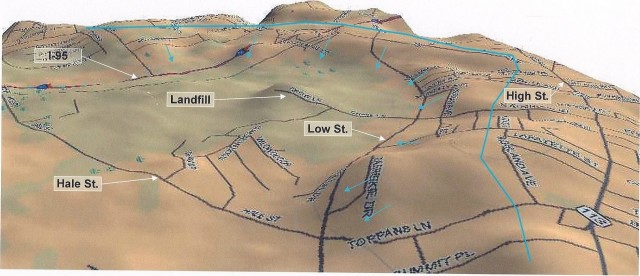What with the renovation at 102-104 High Street, and the Preservation Trust ‘gang’ taking pictures of the ‘tunnel’ in the basement; many who are new to the city or have never been acquainted with the tunnels are requesting the whole ‘story’.
Well, ‘story’ it is; unlike a hideout in a Looney Tune; the owners didn’t want anyone to know what they were building; so no historical records are extant, no local permits and no proud architect, and no sign anywhere of who built them. Smugglers do tend to be a shy bunch. Complicating this discovery are massive cisterns around the city, primitive drainage systems and underground storage vaults – all feverously proclaimed as ‘tunnels’ too.
This is how legends grow, and so this article that appeared in the Daily News‘ long-defunct North Shore magazine in 1978; really sums up the whole story line. Considering all the conspiracy theories bouncing around on the Internet; this one frankly beats the whole lot of them with just enough anecdotal testimony* and facts to make it almost believable: (it could be) Enjoy!!!
The Mystery of Underground Newburyport
By Barbara Buoymaster with Paul Guyton [Highlights by P.P.]
July 29, 1978
Some call it legend, some call it rumor, some romantic exaggeration. Call it what you will, there has long been talk of a series of tunnels connecting the cellars of Newburyport’s older homes with each other and with the harbor.
Many of these cellars show arched outlines of brick in their foundation walls where believers point to what they claim was a tunnel entrance. A few cellars show more – passages leading 20 or 30 feet down and away. When the careful reminiscences of the town’s antique, yet astute residents are considered, even hard-line skeptics are tempted.
Folklore has it that tunnels were built to smuggle goods from vessels moored at Newburyport wharfs. According to the predominant oral history, wealthy merchants built tunnels with their homes because pre-revolutionary trade restrictions and later War of 1812 embargoes threatened a then-burgeoning seaport economy. Decades later runaway slaves were hidden by townspeople who knew about the tunnels and had abolitionist sympathies.
Mrs. Robert Driver has collected Newburyport’s oral and written history during her long life and published a number of articles on the town’s past. She recounted the tunnel’s history as her father and grandfather told it. “They were built during the Embargo Act. Of course during the War of 1812 ships were not supposed to sail so they were tied up at the wharves. It was a terrible time for Newburyport and all New England. They called it Mr. Jefferson’s War and Mr. Jefferson’s Embargo. And there was quite a bit of smuggling going on.”
Leaning forward, her aged blue eyes sparkling, Mrs. Driver told the legend of Captain John Marquand whose North End house reputedly has a tunnel entrance. “It seems he saw one of his ships illicitly sailing into the harbor with flag flying – a signal that all was well – and a full cargo of smuggled goods. He supposedly said, “Dear Lord, see this one ship to safety and I’ll’ not ask for anything more.” And they said that’s the last one of his ships that returned safely. The rest were sunk at sea.”
“Some of the merchants and ship owners found embargo times quite lucrative and some,” she paused, “were bankrupt by them. Many of those that were active in smuggling had tunnels and maintained their wealth through the embargo.” [William Bartlett, the wealthiest man in Newburyport mysteriously thrived after the Great Fire of 1811 while so many others failed or fled]
Written histories of Newburyport lend some support to Mrs. Driver’s interpretation. For one, they record an extreme prosperity that would provide the means to construct an elaborate tunnel system. John Quincy Adams’ Life in a New England Town; “1805 marked the height of Newburyport’s prosperity when customs receipts were the third largest of any port in New England….imports for one month probably totaling $800,000.” [their money not adjusted to today’s value!]
Yet even if merchants had the means, did they have the motivation? The close of the first decade of the 1800’s brought hard times as local historian Albert Hale described in a 1913 speech: “The greatest period of prosperity in Newburyport was in the very last of the 17th century along until 1805…Immediately after this period came hard times…79 vessels stood idle in our wharves.”
So perhaps these times caused merchants to smuggle on a grand scale and tunnels were the best way to hide such quantities of goods. None of the written histories mention tunnels. They have chapters on smuggling, they discuss the disastrous effect of the embargo but even chatty, seemingly all-inclusive memoirs never hint of tunnels.
Mrs. Driver isn’t fazed by this oversight of written history. “The tunnels were kept secret because,” she said, “they were not exactly legal things to have in your cellar.” Besides, Mrs. Driver has a tunnel in her cellar. We saw it. It runs out from the front of her foundation about 30 feet, under and perpendicular to High Street, where it’s been bricked up. She’s been told by some that it was a wine cellar or cold storage. But her cellar had countless rooms of cold storage and none resembles this arched passage, she counters such suggestions, and why would a wine cellar be dug out away from and not under the foundation?
Mrs. Driver is one of many believers. And most of them point to a correlation between merchants who are known to have prospered despite the embargo and cellars with tunnels. William Bartlett is a favorite example. His brick Federalist is now the St. Louis DeGonzague Rectory on Federal Street. John J. Currier’s History of Newburyport, Massachusetts 1764-1909 describes Mr. Bartlett as “the owner of a large fleet of vessels employed constantly in trade with the East and West Indies…In 1787 he purchased land to build a wharf upon at the lower end of Chandler’s Lane (now Federal Street) and subsequently…(bought land) on which he erected warehouses for the storage of sugar, molasses, coffee and hemp…In 1798, Mr. Bartlett purchased additional land and erected a three-story house on Federal Street which he owned and occupied at the time of his death, 1841.
Does that Federal Street house have a tunnel? Not any more. But it does show a brick outline which may have been an entrance. Father Maurice Savard, now at St. Jean the Baptist in Lowell – formerly a 25-year resident of the Federal Street rectory – claims the outline is indeed an entrance. “The smugglers came up the street from the river. Bartlett was a rich man and owned a warehouse on the river. There was a tunnel from that warehouse to what is now the rectory,” he stated unequivocally. “There used to be a hidden staircase coming up from the cellar although when I was there they had taken away the stairs and walled in the tunnel entrance. But many older members of the congregation told me they had been in the tunnel themselves or their fathers had.”
Some supporting oral history was given by Dorice (Noyes) Sunman. She recounted the descriptions that her father, George Noyes (the photographer), gave of tunnel use during the abolitionist period: “The slave tunnel ran right up Federal Street, Dad said. The ships used to come in at the foot of Federal Street. They’d go up in the tower of the French priest’s house (the Bartlett house) and when they saw three lights they’d get a warm coat for the captain, go down and get the slaves and bring them right up the Federal Street tunnel to High Street and that was Mrs. McClintock’s house – the house Mrs. Driver has now. There was a fireplace with a room in back of it so they could get warm and eat. Then the slaves would be led to the cemetery where the tunnel ended and they’d hide in the woods until the carriage-maker had a carriage to deliver. The carriage-maker was against slavery. They’d be dressed like women with bonnets and he had a carriage ready, they’d be taken out of town to the underground railroad or sometimes to a ship headed for Prince Edward’s Island.”
Newburyport was polarized by the slavery issue and anyone aiding runaway slaves did so with guarded secrecy. Mrs. Sunman explained. Those who were found out by their neighbors were reported and punished to the full extent of the law, her father told her.
And George Noyes spoke of three tunnels leading from the river to High Street – under Federal, State and Green Street buildings. These three tunnels became one under High Street and that passage led to the cemetery, he used to say.
A number of people recalled stories of the Green Street tunnel having an entrance in the brick house on the upper corner of Harris at Green. William Bartlett built that house too, according to Currier and Hale, for one of his sons.
“There was a tunnel there,” claims Charles Rowe, governor of the Moose in the early 1950’s when that group made the house its headquarters, “but we never explored it.” It looked “as if it was goin’ from Harris to Merrimac Street” he added, and for years the Moose filled the tunnels with ashes from the coal fires they burned. Today, the entrance gives access to a passage that runs five feet and stops, bricked up.”
Note: This article was accompanied by actual photographs of Mrs. Driver’s tunnel that runs under High Street. The actual copy of the magazine needs to be located! The North Shore Magazine was the forerunner of the Newburyport Magazine and probably included anything from Salem , where the sister paper was located, to Newburyport and included all of Essex County.
Many of the points made in the story do seem to come together rather surprisingly into a cohesive and possible explanation, except the slaves using them. That would be like having slaves travelling down a passage made by the KKK. Newburyport merchants hated the Abolitionists and would have been outraged that slaves were being smuggled through them. On the other hand, Mr. Bartlett was rumored to be smuggling slaves from his docks which has been supported by former slave testimonies though none of them mentioned tunnels.
Mrs. Robert Driver and Mrs. McClintock were obviously tenants as the Register of Deeds show no such persons owning the house in question either past or in the 70’s. (78 High Street)
-P. Preservationist
http://www.ppreservationist.com
* I heard it from my uncle who passed it to his Sister and then was relayed to my Mother.





